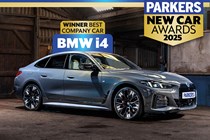
BMW i4 engines, drive and performance

- Three electric powertrains available
- Rear-wheel drive or all-wheel drive
- Good performance across the range
Electric motors
You have a choice of three powertrains in the i4. The most basic eDrive35 has a single, 286hp electric motor on the rear axle and can sprint from 0–62mph in 6.0 seconds, which is more than quick enough – especially if you’re trading up from an older diesel 3 Series.
Above that, there’s the eDrive40. It’s our pick of the range as it has a punchier 340hp electric motor, a faster 0–62mph time of 5.7 seconds and, thanks to its bigger battery pack, a longer maximum driving range. BMW says it can cover 359 miles on a single charge.
Performance is effortless. The i4 accelerates quickly and smoothly, and it’s very easy to modulate the power so that even if you’re going fast, you never jerk your passengers around. The eDrive40 makes for an excellent motorway cruiser, too, with more than enough power in reserve for overtaking.

If you’re hankering for some more performance, don’t worry – BMW has you covered. The M50 has a second electric motor on the front axle, bringing four-wheel drive and boosting power to 544hp. Some of that extra poke is only accessible in ‘Boost’ mode but, with that engaged, the i4 will thrash from 0 – 62mph in 3.9 seconds.
Granted, a Tesla Model 3 Performance will accelerate quicker from a standstill but, in real-world conditions (such as getting from 50–70mph on the motorway), the i4 can keep up.
BMW hasn’t pitched the M50 as an outright M car. Instead, it’s being peddled as an electric rival for the M3 and M4. We think it lacks the drama and finesse to be considered as such. Its fake electric soundtrack is a little contrived and it’s very heavy compared to BMW’s petrol-powered M cars, which means it doesn’t handle as well. But it’s certainly startling in a straight line.

There’s also a clever adaptive regenerative braking feature which uses data from the navigation system and safety sensors to adjust the level of regeneration you get on lifting off the throttle. You can of course switch this off or bypass it by engaging ‘B’ mode. This ramps up the regeneration to max and allows you to drive with the accelerator alone.
What’s it like to drive?
- Superb handling and steering
- Visibility makes urban driving more effort
- The best mainstream EV for the open road
Let’s not beat around the bush – the BMW i4 is one of the very best electric cars to drive on sale today. It strikes a near-perfect balance between handling and comfort, being huge fun to sling through corners but comfortable enough to make long journeys relaxing.
You do feel the i4’s weight when cornering fast, but BMW’s electronic nannies do a great job of keeping everything in shape while also providing a degree of playfulness. And the steering helps, too – it’s precise, direct and quick without being too heavy.

The only thing that counts against the i4’s cornering ability is its 2.1-tonne kerb weight. It’s nowhere near as nimble as the petrol-powered 4 Series. But that’s just par for the course with current EV tech. You can escape the weight penalty.
In terms of driver enjoyment, the i4 knocks the Tesla Model 3 into a cocked hat. The ultimate electric driving machine? We won’t go that far, especially in a world that contains the Hyundai Ioniq 5 N, but we’d definitely put the i4 up there with the Porsche Taycan. It’s that good.









































